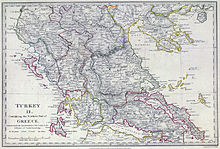
Back Карли-или Bulgarian Karli-Ili Catalan Κάρλελι Greek Karli-Eli Spanish Karlieli French Sangiaccato di Karli Ili Italian Karlıeli Sancağı Turkish
| Sanjak of Karli-Eli Liva-i Karli-Eli | |||||||||||
|---|---|---|---|---|---|---|---|---|---|---|---|
| Sanjak of the Ottoman Empire | |||||||||||
| c. 1480–1821 | |||||||||||
 Map of Central Greece in the early 19th century, showing the sanjak of Karli-Eli ("Karlali") in the lower left corner | |||||||||||
| Capital | Angelokastron, Vrachori | ||||||||||
| History | |||||||||||
• Established | c. 1480 | ||||||||||
| 1821 | |||||||||||
| |||||||||||
| Today part of | Greece | ||||||||||
Karli-Eli (Turkish: Karlıeli, Greek: Κάρλελι, romanized: Karleli), also Karli-Ili or Karlo-Ili,[1] was an Ottoman province (sanjak) in the region of Aetolia-Acarnania in Western Greece from the late 15th century until the Greek War of Independence.
The name, meaning "Land of Charles" in Turkish, derived from the region's last important Christian rulers, Carlo I Tocco (r. 1386–1430), or his nephew and successor, Carlo II Tocco (r. 1430–1448).[2][3][4]
- ^ Cite error: The named reference
EI2was invoked but never defined (see the help page). - ^ Cite error: The named reference
Neratziswas invoked but never defined (see the help page). - ^ Birken, Andreas [in German] (1976). Die Provinzen des Osmanischen Reiches [The Provinces of the Ottoman Empire]. Beihefte zum Tübinger Atlas des Vorderen Orients, 13 (in German). Reichert. p. 55. ISBN 3-920153-56-1.
- ^ Carlo II, according to the review by F. H. M. of Εἰς μνήμην Σπυρίδωνος Λάμπρου, in The Journal of Hellenic Studies, Vol. 55, Part 2 (1935), pp. 271-275, The Society for the Promotion of Hellenic Studies, JSTOR